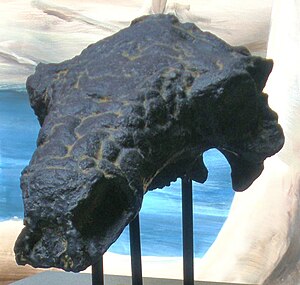Pawpawsaurus
| Pawpawsaurus | ||||||||||||
|---|---|---|---|---|---|---|---|---|---|---|---|---|

Pawpawsaurus campbelli , skull |
||||||||||||
| Temporal occurrence | ||||||||||||
| Lower Cretaceous (Upper Albium ) | ||||||||||||
| 107.5 to 100.5 million years | ||||||||||||
| Locations | ||||||||||||
|
||||||||||||
| Systematics | ||||||||||||
|
||||||||||||
| Scientific name | ||||||||||||
| Pawpawsaurus | ||||||||||||
| Lee , 1996 | ||||||||||||
| Art | ||||||||||||
|
Pawpawsaurus is a genus of pelvic dinosaur from the group of Ankylosauria . It belonged to the Nodosauridae and lived in the late Lower Cretaceous in North America.
features
From pawpawsaurus only has thus far skull known. It was around 25 centimeters long, which gives an estimate of the total length of 4.5 meters. As with all Nodosauridae, the skull was relatively elongated and narrow, but showed some primeval features. The premaxillary (the anterior part of the upper jaw) still had a few teeth, the bony palate was limited to the anterior end of the palate region, and the bony septum was not yet fully developed. The top of the skull was covered by small plates of bone, Pawpawsaurus was the first Nodosauridae to be found to have ossified eyelids (which are more common in Ankylosauridae ). The teeth were small and leaf-shaped and, like all ankylosauria, adapted to a vegetable diet.
The rest of the body is only known from isolated, dubious bone finds. Like all ankylosauria, Pawpawsaurus probably moved on all fours and had armor made of bone plates.
Discovery and naming
Pawpawsaurus fossil remains were discovered in Tarrant County , Texas , and first described in 1996 . The name is derived from the place where it was found, the Paw-Paw formation. The only species and thus type species is P. campbelli . The finds are dated in the late Lower Cretaceous (late Albian ) to an age of 107 to 100 million years.
Systematics
Pawpawsaurus is counted within the Ankylosauria to the basal representatives of the Nodosauridae and is probably closely related to Sauropelta and Silvisaurus . Another ankylosaur named Texasetes has been found from the same formation , of which only parts of the postcranial skeleton have so far been found. Possibly it is the same genus as Pawpawsaurus .
literature
- Matthew K. Vickaryous, Teresa Maryańska , David B. Weishampel : Ankylosauria. In: David B. Weishampel, Peter Dodson , Halszka Osmólska (eds.): The Dinosauria . 2nd edition. University of California Press, Berkeley CA et al. 2004, ISBN 0-520-24209-2 , pp. 363-392.
Individual evidence
- ^ Gregory S. Paul : The Princeton Field Guide To Dinosaurs. Princeton University Press, Princeton NJ et al. 2010, ISBN 978-0-691-13720-9 , p. 235, online